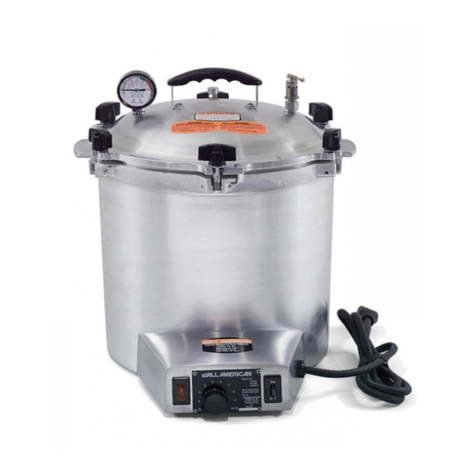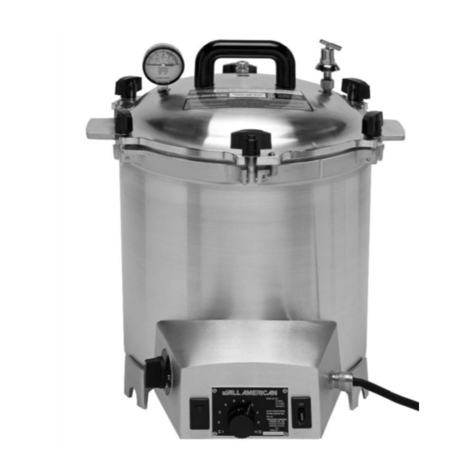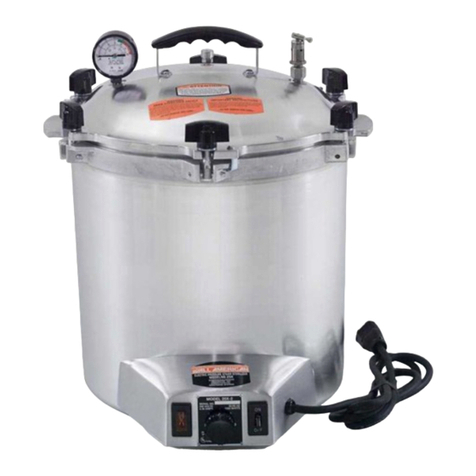
3
OPE ATION
1. LUBRICATE METAL-TO-METAL SEAL.
Apply lubrication to the point or edge where
side wall and bevel meet on the inside of
bottom (See ig. 1 where arrow tip is
pointing). The bevel is not the seat; only the
point or edge where bevel meets the wall. We
recommend using a high temperature lubricant
such as a high vacuum grease. Only a thin film
is required. Excess amounts may cause
leakage or gumming. Most scientific supply
houses have sterilizer lubricant. There are
many brands available. As a substitute, you
may also use petroleum jelly or mineral oil.
2. Remove the cover from sterilizer by turning the
bakelite wing nuts in a counter-clockwise
motion. Always undo two opposite wing nuts
at a time. Next, remove inner container from
the sterilizer (See ig. A, page 2). Make certain
that the stainless steel support stand (See ig.
A) is in the bottom of the sterilizer and that the
opening in the outer ring is in the area of the
heating element. IMPORTANT NOTICE: Place
distilled water to a depth of not less than 2"
nor more than 23⁄4" in the bottom of sterilizer
directly over the heating element, NOT inside
the aluminum container. Place inner container
rack (See ig. A) into the bottom of the
container (See ig. A,) with the lip or edge side
downward. The purpose of the inner container
rack is to provide an air space in the bottom of
the container so that air may circulate freely.
Place articles to be sterilized inside the
container. (Be sure to arrange items so that the
free circulation of steam can occur during
sterilization.) You may wish to place a towel or
cloth on top of the items in the container to
absorb any moisture which may drip down
from the cover. Then place packed container
into the sterilizer. Make certain that the air
exhaust tube channel (located on the inside of
the container) is in position on the right side of
the container when it is placed in the unit. This
is necessary so that when the cover is placed
on the unit you can guide the air exhaust tube
(See ig. A, page 2) into the channel.
If the water you have placed in the unit is cold, it
will require approximately 35 minutes before
steam begins escaping from the control valve.
Since it requires more time to bring cold water up
to operating temperature than it takes warm or hot
water, you can reduce this time factor by:
A. Pouring in hot water in place of cold, or
B. Pouring in cold water and then turning on the
unit so that the water is getting warmed prior to
your beginning the sterilization procedure
In both cases, observe the proper water level.
3. lace sterilizer cover on unit, making
sure that the index alignment arrow on
the cover aligns with index line/arrow
on side of bottom. Make certain when
placing the cover on the unit that the flexible
tube is inserted into the guide channel on the
inside wall of the aluminum container. It is
helpful to place the container in the unit with
the guide channel on the right hand side as
you face the unit. Tighten the wing nuts on the
cover evenly, always tightening down two
opposite wing nuts at one time. This will draw
the cover down evenly and assure a proper
seal. NEVER USE A WRENCH OR ANY
MECHANICAL DEVICE TO TIGHTEN WING
NUTS. NEVER HAMMER OR STRIKE THE
WING NUTS OR COVER WHILE OPENING OR
CLOSING.
4. Plug power supply cord into the proper outlet.
Keep in mind that if your unit operates on 120
volts, the plug contacts would have a different
configuration from a unit designed to operate
on 240 volts. Please refer to the dial plate on
the front of the control box and note in the
upper left-hand corner if your unit is 120 or
240 volts. Next, turn the on/off toggle switch to
“on” position. Now turn the control knob #4160
to the setting of “10”. At this time, the red pilot
light will come on indicating that current is
going into the unit and that the heating element
is operating.
5. Open CONTROL VALVE (See ig. 2) by placing
valve lever in an upright position. The steam
generated at the bottom of the sterilizer will
travel around the outside of the container and
then down through the material in the
container to the bottom and force the air from
the bottom of container up through the flexible
air exhaust tube and out of the control valve.
It is important that the steam be
permitted to escape vigorously from the
unit for at least five-seven minutes, or
until you see a continuos flow of steam.
Then you may close the control valve.
This process of permitting the steam to escape
is called EXHAUSTING and is necessary to
remove the air trapped in the unit. The
greatest cause of sterilization failure is
the trapping of air in the material being
sterilized. Trapped air cannot escape. It
is imperative that all trapped air be
exhausted. With the control valve in the
closed position (See ig. 3), pressure will rise
inside the sterilizer and will be indicated on the
pressure gauge.
ig. 1
Metal-to-metal seal
Apply lubricant here
Open control
valve
Closed control
valve
ig. 2 ig. 3
Petcock horizontal
or closed
valve body
steam escape
holes
Petcock
vertical or
open































